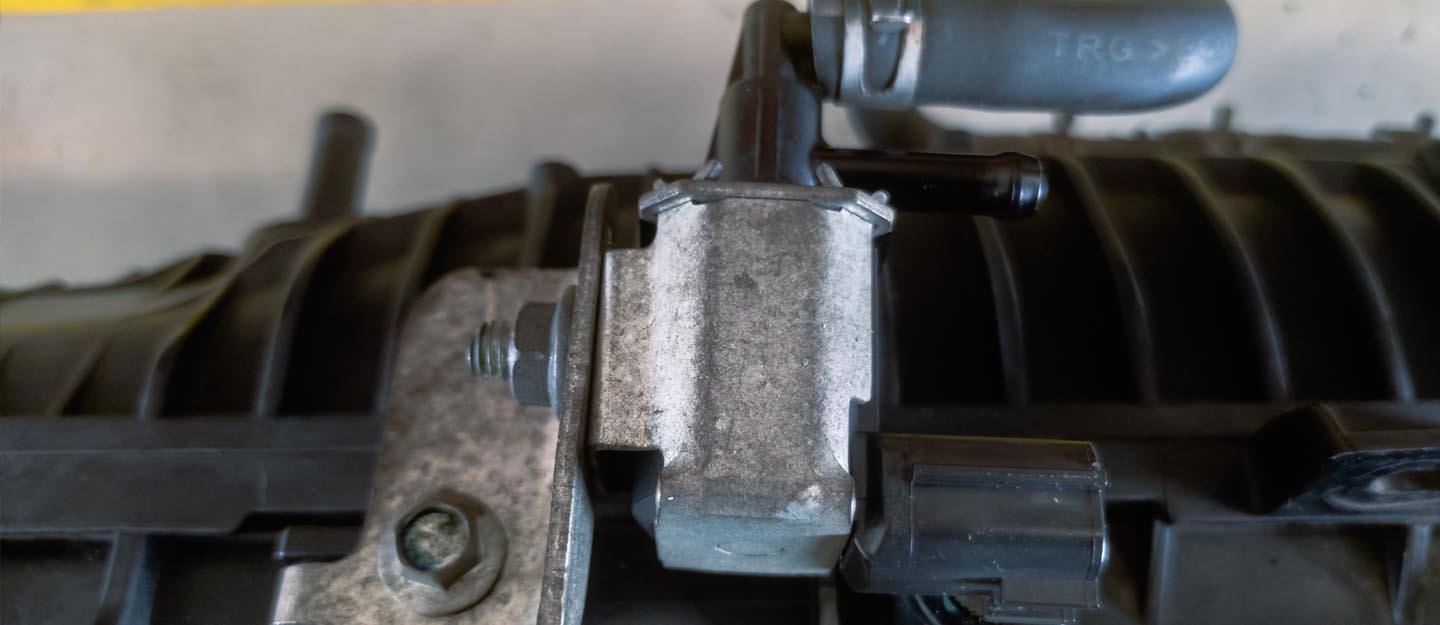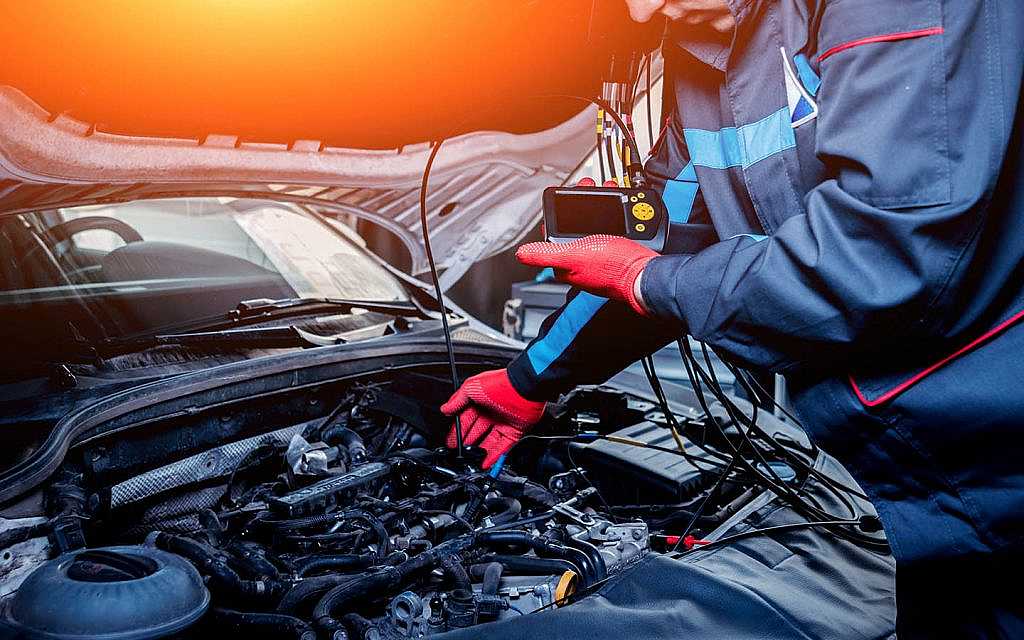
- Location
- Working
- Causes of Malfunction
- Diagnoses and Fixes
- FAQs
A car’s evaporative emission control (EVAP) system consists of several components like the purge valve. It prevents the fuel vapours from escaping into the atmosphere. When pressure accumulates, the purge valve directs these vapours to combust in the engine, reducing the car’s emissions. That said, a functional purge valve is necessary for a vehicle’s good fuel efficiency and overall performance.
Here, we have penned the importance and working of a purge valve, the factors that affect its performance and how to fix these issues.
Where Is the Purge Valve Located?
In most car models, the purge valve is connected to the charcoal canister, which stores fuel vapours from the fuel tank. The valve is mounted on or near the intake manifold or car throttle body, as it needs to be close to the engine for efficient vapour delivery during combustion. However, in some cars, the purge valve location is found in the canister. Professional car inspection services by dubizzle can also help locate the purge valve.
How Does A Purge Valve Work?
A purge valve in a car manages and reduces the release of fuel vapours into the atmosphere. The system captures and stores fuel vapours from the fuel tank in a charcoal canister when the engine is off, preventing them from escaping into the air. When the engine runs, the purge valve opens and draws the vapours into the engine’s intake manifold and burns them during combustion.
Moreover, in modern cars, the engine control module (ECM) or car computers control the purge valve. It determines the optimal time to activate the valve. Besides, factors such as engine temperature, throttle position and the status of the evaporative emissions control system are taken into account.

By analysing these inputs, the ECM optimises the purge valve function for efficient combustion of fuel vapours. This control mechanism helps the vehicle comply with environmental regulations and maintain optimal fuel efficiency.
Reasons a Car’s Purge Valve Malfunctions
A car’s purge valve may malfunction due to various reasons and these issues can impact its ability to effectively control fuel vapour emissions. Some common reasons for purge valve malfunctions include:
Mechanical Failure
Over time, the purge valve experiences mechanical wear and tear, leading to issues such as sticking, binding or failure to open or close properly. This disrupts the normal operation of the valve and affects its ability to control the flow of fuel vapours.
Electrical Problems
The purge valve is often electronically controlled by ECM. Electrical issues, such as damaged wiring, faulty connectors or problems with the ECM itself interfere with the purge valve function.
Vacuum Leaks
The purge valve relies on a vacuum to operate. If there are leaks in the vacuum lines or connections associated with the purge valve, it can lead to a loss of vacuum pressure, affecting the valve’s performance.
Contamination

Dirt, debris or carbon buildup in the purge valve hinders its movement and compromises its ability to open and close. Contamination can occur over time, particularly if the engine is exposed to harsh driving conditions or poor-quality fuel.
Stuck, Open or Closed Position
A purge valve stuck in the open position may cause excessive fuel vapours to be drawn into the engine, affecting combustion and causing drivability issues. Conversely, a purge valve stuck in the closed position may lead to a buildup of pressure in the EVAP system.
Faulty Charcoal Canister
The purge valve works in conjunction with the charcoal canister, which stores fuel vapours. If the canister is saturated with fuel or fails to function properly, it impacts the purge valve’s function and performance.
Evaporative Emissions System Leaks
Leaks in other components of the EVAP system, such as the fuel tank, fuel filler neck or hoses, affect the overall pressure and operation of the system, leading to purge valve issues.
Software or Calibration Issues
Software or calibration issues with the engine control module can result in incorrect signals being sent to the purge valve. This, in turn, may cause the purge valve to malfunction and operate improperly.
How to Diagnose and Fix a Bad Purge Valve
Like any other car component, a purge valve is prone to malfunction. That said, you can refer to the below-listed fixes and diagnosis if you notice any symptoms of a bad purge valve like rough idling or poor engine performance.

Diagnosing and fixing a bad purge valve involves a systematic approach. It encompasses the following steps.
Check Engine Light
A malfunctioning purge value can also be a reason behind the illumination of the check engine light. Use an OBD-II scanner to retrieve error codes. Specific codes related to the evaporative emissions system or the purge valve code like P0433 can provide valuable diagnostic information.
Visual Inspection
Inspect the purge valve and associated hoses for physical damage leaks or contamination. Ensure all connections are secure.
Vacuum Testing
Perform a vacuum test on the purge valve and associated hoses to identify leaks or vacuum-related issues. Repair or replace any damaged components.
Electrical Inspection
Check the electrical connections to the purge valve for damage or corrosion. Measure the electrical resistance of the valve using a multimeter.
After you have diagnosed a malfunctioning purge valve, here’s how you can fix it. However, if the damage is to a greater extent, we advise you to replace it.
Replace the Purge Valve
If the purge valve is confirmed to be faulty, replace it with a new one. Consult the vehicle’s service manual for the correct part and follow proper installation procedures.
Address Vacuum Leaks
Repair and detect car vacuum leaks or connections that are damaged. Ensure a tight seal to maintain proper vacuum pressure. A faulty purge valve may also make it difficult to start a car after getting fuel.
Clear Error Codes
After fixing the issue, use the OBD car scanner to clear any stored error codes. This will reset the Check Engine Light.

Verify Repair
Test the vehicle by driving it to see if the Check Engine Light remains off. Monitor the system for any abnormalities in fuel efficiency or drivability.
Professional Assistance
If the issue persists or if you are unsure about the diagnosis and repair, seek professional assistance from a qualified mechanic. They can perform a more in-depth diagnosis and ensure accurate repair.
FAQs
What Is A Purge Valve?
A purge valve is a part of the EVAP system and controls the release of fuel vapours into the engine. In modern cars, the valve is electronically controlled by the ECM to maintain a proper car air-fuel ratio.
What is the Importance of Your Car’s Purge Valve?
The purge valve is crucial for controlling fuel vapours, optimising emissions and enhancing fuel efficiency in your car. It ensures compliance with environmental standards and contributes to smooth engine performance.
What is the Cost of a Purge Valve Replacement?
The cost of a purge valve replacement in the UAE can vary depending on the car make and model, but it ranges from AED 150 to AED 500, with additional labour costs.
How to Test a Purge Valve with a Multimeter?
Testing a purge valve with a multimeter involves checking its electrical continuity. Disconnect the electrical connector from the purge valve, set the multimeter to measure resistance (ohms), and connect the probes to the terminals. A working purge valve shows low resistance, while a high or infinite reading may indicate a faulty valve that requires replacement.
That is all on the purge valve and why it is important in a car. In addition, when buying a used car in the UAE, always check for the proper functioning of all components for a smooth ride. It will save you from the hassle of untimely repairs and additional maintenance costs.
For more on different car components and their function, stay tuned to dubizzle’s autos blog.
Нет Ответов